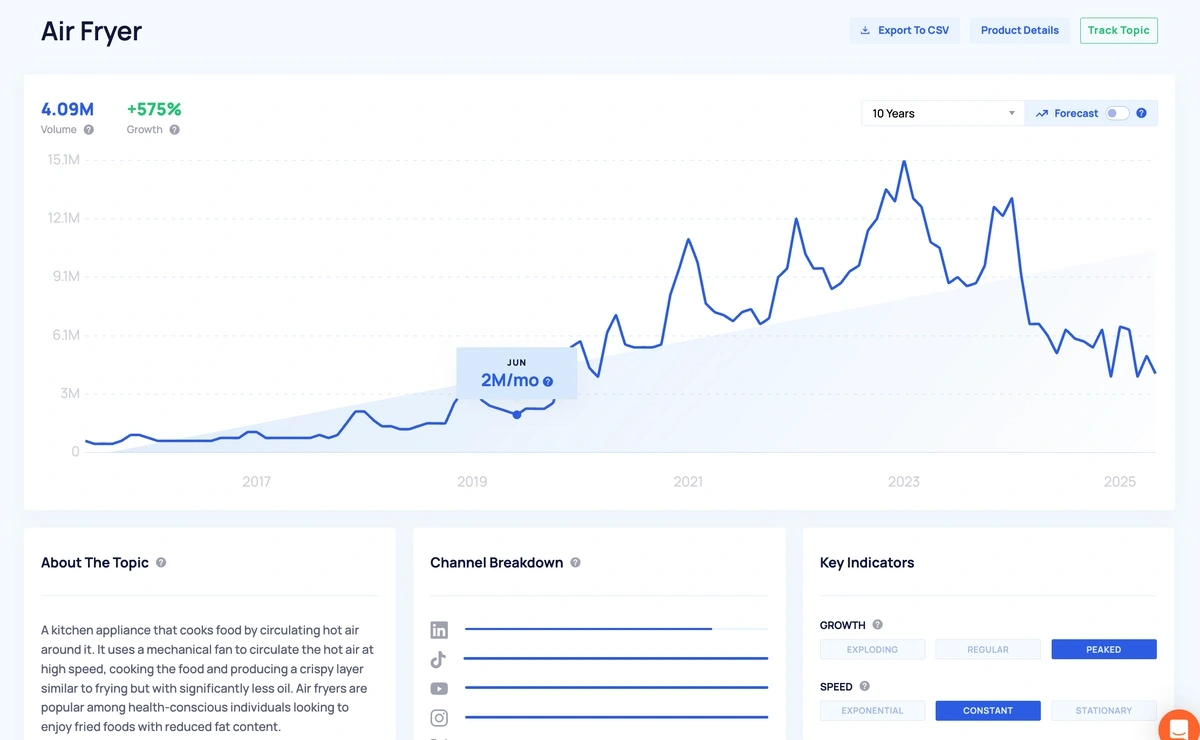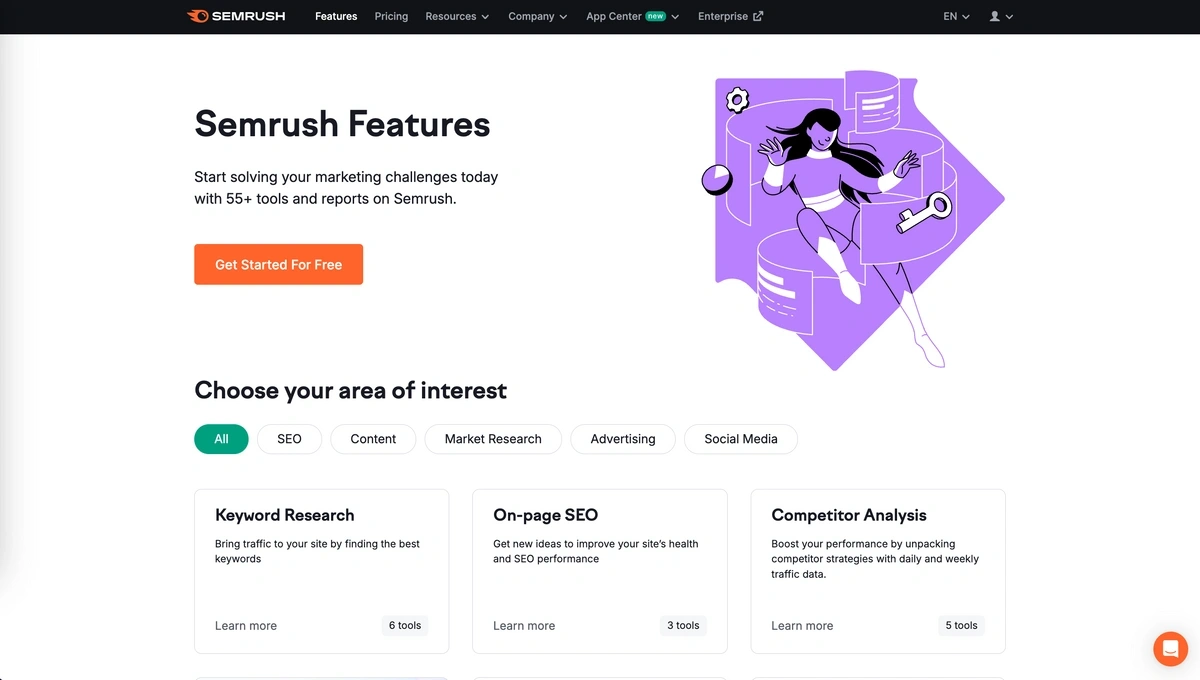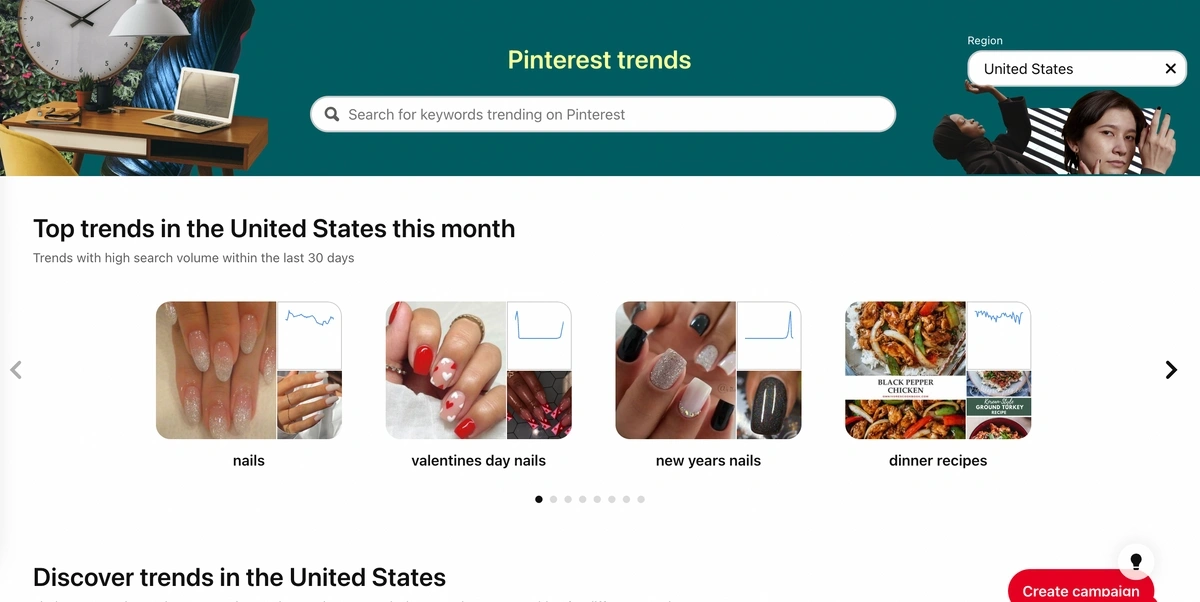
Top 10 Google Trends Alternatives (2025)
This is a list of the top Google Trends alternatives for 2025.
Google Trends is great for researching the popularity of a given keyword.
That said, Google Trends is pretty limited in terms of features.
For example, you can't really use it to discover new, up-and-coming trends that aren’t on your radar yet. Plus, you usually need an additional SEO or marketing tool to research any trending terms that you find.
With that, here are the top 10 Google Trends alternatives to know:
1. Exploding Topics
Exploding Topics scans every corner of the web to find upcoming trends in dozens of categories. That way, you can discover trending topics and products before everybody else knows about them.
Unlike Google Trends, you don’t need to know exactly what to search for. Just select a category of interest and review the trends in our database of over 1M topics.
And that’s one of the most main differences between Google Trends and Exploding Topics: Google Trends lets you research trending topics you already know about. Exploding Topics lets you discover new trends before you would even know to research them.
For example, a growing trend that we identified back in May of 2020 was "AI writing tool":
Search interest in that SaaS category has increased by 50x since we first identified it.
Exploding Topics can also be helpful for identifying trending physical products.
In fact, we first found "air fryers" in June of 2019: over 18 months before the product category really took off.
Notably, Exploding Topics also offers something else Google Trends doesn't: trend forecasting.
This is ideal for marketers looking for "the next big thing". Investors are looking to inform investment decisions. Or ecommerce businesses wanting to predict future demand.
Exploding Topics API
The Exploding Topics API extends the platform’s trend discovery into your own tools and workflows. Instead of manually checking the platform, you can feed trend data into dashboards, inventory planning tools, or content workflows.
The key difference from Google Trends and the Exploding Topics API is the focus on emerging products, startups, and keywords with growth forecasts. In contrast, Google Trends only reflects historical search activity.
That makes the API especially valuable for ecommerce teams planning inventory, content strategists building programmatic SEO workflows, or investors tracking early signals.
Integrating Exploding Topics data directly allows you to move faster on new opportunities and validate decisions before competitors take notice of specific trends.
API access is part of the Pro plan. You can see an Exploding Topics Pro vs free plan breakdown here.
We would always recommend our platform. But if you want to explore in more detail, you can see a comparison of Exploding Topics alternatives.
2. Semrush
Semrush is a robust online marketing platform for social media marketers, content marketing teams and bloggers, and other digital marketers.
Semrush has features to support every step of content strategy and creation, from researching keywords to writing content and planning paid ads. Plus, it includes analytics tools such as a rank tracker that lets you monitor page rankings, and competitor analysis features to keep an eye on what content they’re publishing and see how others talk about competitors online.
Semrush is described as user-friendly and doesn’t require much training to learn and use. They also have three packages to appeal to different users. The most basic plan lets you do keyword research, track keywords, manage backlinks, and optimize website page content.
The enterprise plan gives you access to all of those features as well as integrations with Google Studio (including Google Analytics) and other extras. They also have custom plans for teams with really specific needs.
Despite the software’s ease of use, teams without a lot of technical SEO knowledge may not be able to leverage all of the available features and may end up paying for tools they don’t necessarily use. So this isn’t the best option for teams who just need more advanced keyword research software.
Pricing for Semrush ranges from $139.95 to $499.95 per month, with discounts of up to 17% available when billed annually.
3. Treendly
Treendly advertises itself as “Google Trends on steroids” — this platform provides a trend database and custom trend reports so users can explore new trends in their specific industry.
They offer features to search and filter trends, look at trend data in different geographic locations, predict trend growth, and save trends to a library. Treendly also lets you look at popular searches by platform; you can see Google searches, YouTube searches, and even what customers search on Amazon. This breakdown can be helpful for e-commerce teams or digital marketers who want to see how people are using these sites and what they’re searching for or purchasing.
Treendly offers two paid packages — the Starter package for $49/mo and an Enterprise plan (they do not list Enterprise pricing on their website; you have to request a quote).
If you’re going to use Treendly, you’re probably better off choosing the Enterprise package because there are some limitations with the Starter plan. For example, the Starter plan only lets you track 25 trends and does not grant access to custom reports.
4. Trend Hunter
Trend Hunter is exactly what it sounds like: a website focused on spotting trends (with a focus on physical products).
However, Trend Hunter doesn’t rely too much on search to identify trends. This can actually be a good thing as it can help you get exposed to trends that you’re not familiar with yet. They also tend to be good at spotting trends that are popping off on sites like TikTok, Instagram, and X (formerly Twitter).
Unlike Google Trends, you can’t just search for any word or phrase and see data on that keyword.
In that way, Trend Hunter is more of a discovery tool than one you’d use to really drill down into how a specific keyword is trending.
Specifically, Trend Hunter essentially has a giant database of trends (431,000 according to their website) that you can browse through. They also have a number of products, including a trend platform and custom reporting.
5. Insider Intelligence
Insider Intelligence (powered by eMarketer and Business Insider) is a subscription-based trends newsletter.
However, unlike Meet Glimpse, Insider Intelligence sends trend reports every single day. Specifically, they deliver trend info on a variety of industries and categories. That way, you can browse the information and find what’s relevant to you. You can also search topics in Insider Intelligence, and they have tools to look at trend projections.
Insider Intelligence also offers a library of content about these upcoming trends — you can access interviews with experts, blog articles, reports, and infographics. For example, one of their recent reports has research on trends in the advertising industry, another offers a deep dive into Gen Z. Reviews of Insider Intelligence mention that it’s more of a news platform and resource hub than a trends database. So while you can’t necessarily save or track trends, you have access to articles to learn more about them.
Insider Intelligence does not disclose pricing on its site, but it offers three plans for different team sizes and user needs.
6. Ahrefs
Ahrefs is a digital marketing and SEO software suite. It's the subject of many "Ahrefs vs Semrush" debates.
Its features enable teams to:
- Research keyword opportunities and look at things like search volume and keyword difficulty.
- Discover new content ideas and link-building opportunities.
- Monitor how website pages rank for specific keywords (and identify content that doesn’t rank well so you can plan updates for it).
- Research competitor content, rankings, and backlinks.
- Pinpoint technical SEO issues and make those fixes.
- Organize and track SEO projects in a team dashboard.
This software is tailored for marketing teams that want to grow organic traffic and keyword rankings, address their site's technical SEO, improve website performance, and find opportunities for link building.
However, it’s worth mentioning that Ahrefs is not for the “beginner” marketer, as some of the features are pretty sophisticated and require previous SEO knowledge to use. It’s also not the best option for paid ads or social media teams because it doesn’t have features to create and schedule ads, track ad performance, or monitor social media campaigns.
Ahrefs offers four paid plans. Each plan includes different SEO features and usage limits. And prices range from $99 to $999 per month.
7. AnswerThePublic
AnswerThePublic is the ideal alternative for readers who just want a keyword tool to look at Google searches and plan content ideas.
You can use their site for free (the free tool allows a limited number of searches each day) or you can buy one of the paid packages to unlock unlimited daily searches.
AnswerThePublic’s paid packages also include features like folders to organize related keyword ideas together, reporting tools to compare popular Google searches during different periods, and real-time alerts for new keyword ideas.
Reviewers like AnswerThePublic because it generates a high volume of keyword ideas for any topic you type into the search bar, and it organizes these keywords by “type.” For example, you could search “renewable energy,” and it’ll populate:
- Question-based keywords (“Which renewable energy to invest in?”)
- Comparison keywords (“Renewable energy vs fossil fuels”)
- Searches with prepositions (“Renewable energy near me”)
It also displays all related keywords in an alphabetical list, so you can browse keywords based on your interest and discover new keyword ideas. The biggest downside, though, is that it doesn’t show the search volume for any of the keywords. So while you can find keyword ideas, you can’t see any data around how often the search is done or how difficult it’ll be to rank for the keyword.
AnswerThePublic has three paid offerings, and prices range from $9/mo for a very basic plan to $199/mp for a feature-rich "Expert" plan.
8. Pinterest Trends
Pinterest Trends is essentially Google Trends from Pinterest.
In other words, it auto generates a list of trending topics on the platform. Like Google Trends, you can view trending topics by region.
However, to view all the trends that Pinterest offers, you do need to log in. Once you do, you’ll be presented with a pretty solid tool for discovering trends. Not only do you get a list of topics that are growing in interest over the last month/12 months, but the tool also displays their percentage growth over each time frame.
Notably, unlike Google Trends or many of the other tools on this list, you can actually view topics that are trending among specific demographics (like age and gender).
You can also filter trends based on interests, like electronics, beauty, health, and gardening. This makes it easy to “zoom in” to a specific industry or niche.
The only real downside of Pinterest Trends is that it doesn’t cover a wide range of industries or topics. The vast majority of trends tend to be related to the same handful of topics: beauty, home, fashion etc. So if you work in any of those spaces, this tool is an ideal fit. But if you’re a tech-focused niche, you probably won’t find many interesting trends in Pinterest Trends.
9. Keyword Tool
Keyword Tool is focused on generating autocomplete suggestions from various search engines (Google, Amazon, eBay, and Instagram).
Autocomplete suggestions are typically made up of trending searches (which is why a search engine will suggest them). This makes Keyword Tool helpful for identifying search terms that are growing in popularity.
Keyword Tool even has a dedicated tool for getting keyword suggestions from Google Trends itself. Specifically, it pulls keyword ideas from the “related topics” and “related queries” sections of Google Trends.
What makes Keyword Tool a bit more helpful than just using Google Trends is that it populates each keyword suggestion with helpful SEO-focused data, like CPC and competition in the search results.
Keyword Tool does allow you to get some of their data for free. But they require a paid account to see all the keyword suggestions and data.
10. Similarweb
Similarweb is a digital marketing platform focused on competitor intelligence.
More specifically, you enter a competitor into the tool. And you get back a bunch of traffic-related metrics about their website, including:
- Estimated monthly visitors
- Major traffic sources
- Top organic (SEO) keywords
- Engagement metrics (bounce rate and page views)
- Counties that make up the largest chunk of the site’s user base
As a digital marketing platform, Similarweb is pretty stacked with features. However, it’s not the best option if you’re looking for something like Google Trends that isn’t actually Google Trends.
Unlike Google Trends, Similarweb doesn’t focus that much on keyword research (although they do have a solid keyword tool as part of their paid product). And they definitely don’t focus on trends all that much.
So why list them as a potential alternative to Google Trends? Because you can use it to uncover a site’s top-ranking keywords (which are often trending). And you can use the tool to find fast-growing websites. Which can be keywords to optimize your content around (for example, “Website review”, etc.).
Key Takeaways
That wraps up our list of alternatives to Google Trends. As you can see from this list, no tool can completely replace Google Trends. It's a solid tool that's used by millions to research trends.
However, there are a number of free and paid tools that supplement or complement what Google Trends brings to the table. For example: Exploding Topics.
You can browse the Exploding Topics database on our website for free to get a glimpse of the available trend data. We also offer a 14-day trial of Exploding Topics Pro so you can access all of our early trend data, meta trend information, reports, and trend tracking features. Get started with Exploding Topics Pro for $1.
Stop Guessing, Start Growing 🚀
Use real-time topic data to create content that resonates and brings results.
Exploding Topics is owned by Semrush. Our mission is to provide accurate data and expert insights on emerging trends. Unless otherwise noted, this page’s content was written by either an employee or a paid contractor of Semrush Inc.
Share
Newsletter Signup
By clicking “Subscribe” you agree to Semrush Privacy Policy and consent to Semrush using your contact data for newsletter purposes
Written By


Josh is the Co-Founder and CTO of Exploding Topics. Josh has led Exploding Topics product development from the first line of co... Read more















